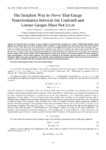
Please use this identifier to cite or link to this item:
http://ricaxcan.uaz.edu.mx/jspui/handle/20.500.11845/546Full metadata record
| DC Field | Value | Language |
|---|---|---|
| dc.contributor.other | https://orcid.org/0000-0001-5324-1834 | es_ES |
| dc.contributor.other | https://orcid.org/0000-0002-1478-7946 | es_ES |
| dc.coverage.spatial | Global | es_ES |
| dc.creator | Chubykalo, Andrew | - |
| dc.creator | Espinoza, Augusto | - |
| dc.creator | Alvarado Flores, Rolando | - |
| dc.date.accessioned | 2018-06-12T16:30:43Z | - |
| dc.date.available | 2018-06-12T16:30:43Z | - |
| dc.date.issued | 2013-12 | - |
| dc.identifier | info:eu-repo/semantics/publishedVersion | es_ES |
| dc.identifier.issn | 1916-9795 | es_ES |
| dc.identifier.issn | 1916-9809 | es_ES |
| dc.identifier.uri | http://hdl.handle.net/20.500.11845/546 | - |
| dc.identifier.uri | https://doi.org/10.48779/vz6q-bk37 | - |
| dc.description.abstract | In this brief paper we propose to prove a theorem on non-classical symmetries for systems of differential equations whose solutions are related by means of a linear constraint. What we obtain is a representation of the invariance group of the system given by (∩𝒊𝒊=𝟏𝟏𝑵𝑵𝑮𝑮𝒊𝒊)∪𝑮𝑮𝑵𝑵𝑵𝑵𝑵𝑵 where the groups 𝑮𝑮𝒊𝒊 are the classical Lie groups of each differential equation in the system taken separately, and 𝑮𝑮𝑵𝑵𝑵𝑵𝑵𝑵 is the non-classical symmetry group obtained when the set of determining equations is solved for the whole coupled system. Once we have the theorem, we apply it to the system of equations that define the scalar potential in the Coulomb and Lorenz gauges. It is well-known that the solutions of the scalar potential in the Coulomb gauge are related to the solutions of the scalar potential in the Lorenz gauge by a gauge transformation, however, these equations have been not considered in the literature from the point of view of its constrained symmetries. When this is done, it is possible to prove that the scalar potential in the Lorenz gauge cannot accept the Lorentz boost as a symmetry, which is excluded by the linear constraint introduced by the gauge transformation. | es_ES |
| dc.language.iso | eng | es_ES |
| dc.publisher | Canadian Center of Science and Education | es_ES |
| dc.relation | http://www.ccsenet.org/journal/index.php/jmr | es_ES |
| dc.relation.uri | generalPublic | es_ES |
| dc.rights | Atribución-NoComercial-CompartirIgual 3.0 Estados Unidos de América | * |
| dc.rights.uri | http://creativecommons.org/licenses/by-nc-sa/3.0/us/ | * |
| dc.source | Scientific Journal of Mathematics Research, Vol. 3, Núm. 6, Diciembre 2013. | es_ES |
| dc.subject.classification | CIENCIAS FISICO MATEMATICAS Y CIENCIAS DE LA TIERRA [1] | es_ES |
| dc.subject.other | Electromagnetic Field | es_ES |
| dc.subject.other | Lorenz and Coulomb Gauges | es_ES |
| dc.title | The Simplest Way to Prove That Gauge Transformation between the Coulomb and Lorenz Gauges Must Not Exist | es_ES |
| dc.type | info:eu-repo/semantics/article | es_ES |
| Appears in Collections: | *Documentos Académicos*-- UA Física | |
Files in This Item:
| File | Description | Size | Format | |
|---|---|---|---|---|
| 2013 Scientific Journal of Mathematics Research.pdf | 217,35 kB | Adobe PDF |  View/Open |
This item is licensed under a Creative Commons License
